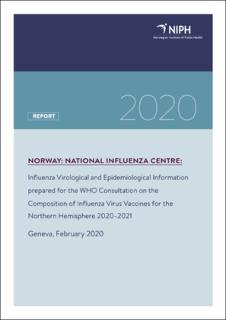| dc.contributor.author | Bragstad, Karoline | |
| dc.contributor.author | Paulsen, Trine Hessevik | |
| dc.contributor.author | Tønnessen, Ragnhild | |
| dc.contributor.author | Klüwer, Birgitte | |
| dc.contributor.author | Rydland, Kjersti Margrethe | |
| dc.contributor.author | Hungnes, Olav | |
| dc.date.accessioned | 2022-02-09T08:09:19Z | |
| dc.date.available | 2022-02-09T08:09:19Z | |
| dc.date.created | 2022-02-07T10:53:38Z | |
| dc.date.issued | 2020 | |
| dc.identifier.isbn | 978-82-8406-064-4 | |
| dc.identifier.uri | https://hdl.handle.net/11250/2977861 | |
| dc.description.abstract | • Seroepidemiology data from August 2019 indicate that immunity in Norway against circulating influenza A(H1N1) was quite strong, with considerable immunity also against clade 3C.2a A(H3N2) viruses but with much poorer antibody levels against clade 3C.3a viruses. There was also some immunity against currently circulating B/Yamagata lineage viruses, but much less against B/Victoria-lineage viruses.
• Added to this comes the immunity due to the subsequent influenza vaccination campaign in the autumn. Vaccination rates were raised compared to the 2018/19 season.
• The influenza activity crossed the outbreak threshold during Christmas (week 52/2019). After a small peak in week 1, the influenza activity increased again in week 4/2020 and was at that point on a low level intensity.
• In week 4, the number of hospitalisations was increasing and at a medium level comparable to the preceding season. Overall, the highest hospitalisation rates were found in the elderly (60 years or older), followed by young children. The same pattern was seen for influenza A, but for influenza B the highest hospitalisation rates were found in children (0-4 and 5-14 years).
• Excess all-cause mortality has mainly been within expected levels.
• There is no clearly predominant virus. Influenza A(H3N2) virus is the most numerous, constituting approximately 50% of detections. Second-most numerous is influenza B of the Victoria lineage, making up 28%, followed by influenza A(H1N1) (19%) and with only 4% being B/Yamagata lineage.
• The majority of the H3N2 viruses belong to the 3C.2a1b subgroup of viruses with the T131K substitution.
All the characterised influenza B-Victoria viruses have been triple-deletion variants like B/Washington/02/2019. | |
| dc.description.abstract | Det nasjonale influensalaboratoriet for WHO i Norge (WHO National Influenza Centre Norway), Avdeling for Influensa, FHI, utarbeider en rapport til WHO hver februar og september som beskriver influensasituasjonen i Norge og som tas med i vurderingen ved bestemmelse av ny influensavaksine. Rapporten går i dybden og tar for seg immuniteten i befolkningen og genetiske karakteriseringer av sirkulerende virus i Norge. Rapporten sammenfatter data og analyser fra den kliniske overvåkingen, virusovervåkingen og den seroepidemiologiske overvåkingen i Norge. | |
| dc.language.iso | eng | |
| dc.publisher | Norwegian Institute of Public Health / Folkehelseinstituttet | |
| dc.relation.uri | https://www.fhi.no/globalassets/dokumenterfiler/rapporter/2020/influensa-who-rapporter/nic-norway-mid-season-influenza-report-for-who-vcm-february-2020-final.pdf | |
| dc.subject.mesh | Viral Vaccines | |
| dc.subject.mesh | Influenza Vaccines | |
| dc.subject.mesh | Influenza, Human | |
| dc.subject.mesh | Epidemiological Monitoring | |
| dc.subject.mesh | Geographic Mapping | |
| dc.subject.mesh | Norway | |
| dc.subject.mesh | Epidemiologisk overvåking | |
| dc.subject.mesh | Influensa | |
| dc.subject.mesh | Vaksinasjon | |
| dc.subject.mesh | Geografisk kartlegging | |
| dc.subject.mesh | Norge | |
| dc.title | Norway National Influenza Centre: Influenza Virological and Epidemiological Information prepared for the WHO Consultation on the Composition of Influenza Virus Vaccines for the Northern Hemisphere 2019–2020 Geneva, February 2020 | |
| dc.title.alternative | Norsk influensarapport til WHOs møte om sammensetning av influensavaksinen for nordlige halvkule 2020/2021 | |
| dc.type | Research report | |
| dc.description.version | publishedVersion | |
| dc.source.pagenumber | 32 | |
| dc.identifier.cristin | 1998455 | |
| cristin.ispublished | true | |
| cristin.fulltext | original | |
